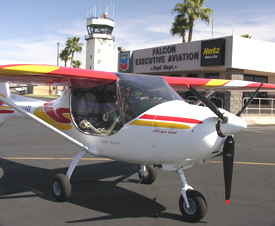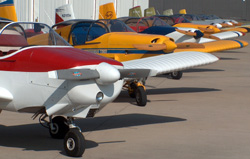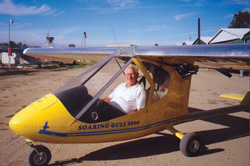
One of my favorite lines comes from a man associated with trying to perfect the airplane convertible to a car. Molt Taylor is reported to have said, “An airplane will get you from one place you don’t want to be to another place you don’t want to be: the airport.” Indeed too many American airports are simply places to get your plane out of the hangar…and leave. How handy would it be to fly in, land, and quickly transform your plane into your automobile? So, the aerocar idea remains alive. Now, a development team associated with highly regarded MIT is promoting the Transition. Why cover a concept in the early stages? Because Transition is being built to meet LSA definitions. While looking novel, I especially like that you carry the wings with you when motoring on the highways (check their web movie). Most other concepts call for removing the wings, a cumbersome process at best.











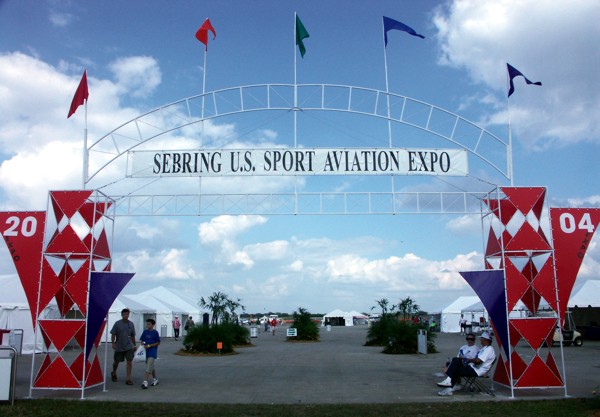










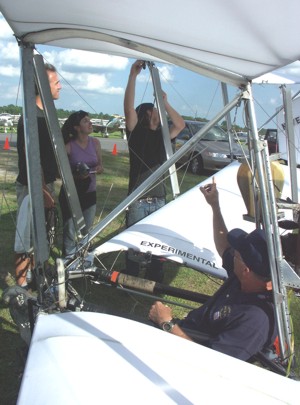














 The motion isn't hard-though some designers have added mechanical advantage to make it easier-and the turn is more responsive that you might imagine. But what if you don't have good use of your legs? How might you fly a powered parachute?
The motion isn't hard-though some designers have added mechanical advantage to make it easier-and the turn is more responsive that you might imagine. But what if you don't have good use of your legs? How might you fly a powered parachute?
 Canadian powered parachute manufacturer Para-Ski offers a handlebar arrangement, and other companies have experimented with similar ideas. But nearly every other supplier of these flying machines uses a foot-steering arrangement of one kind or another. James Leon of Kankakee, Illinois, has another alternative.
Canadian powered parachute manufacturer Para-Ski offers a handlebar arrangement, and other companies have experimented with similar ideas. But nearly every other supplier of these flying machines uses a foot-steering arrangement of one kind or another. James Leon of Kankakee, Illinois, has another alternative.
 "This system was designed for the paraplegic pilot who must release the throttle lever to operate their steering via hand controls," Leon said. "Our system allows you to steer, flare and set trim with one hand while operating the throttle with the other hand."
According to Leon, his system uses "the best cylinders, control valves and certified air tank that we could find." The system has a pressure relief valve, air regulator, gauge and onboard compressor, which he says "draws very little amperage."
"This system was designed for the paraplegic pilot who must release the throttle lever to operate their steering via hand controls," Leon said. "Our system allows you to steer, flare and set trim with one hand while operating the throttle with the other hand."
According to Leon, his system uses "the best cylinders, control valves and certified air tank that we could find." The system has a pressure relief valve, air regulator, gauge and onboard compressor, which he says "draws very little amperage."
 A beginner could easily learn the hand controls from the aft seat while an instructor overrides the system, if necessary, from the front. It shouldn't take long as the controls are obvious-pull right to go right, pull left to go left and pull both to flare.
The air steering system costs $1500 installed including all hardware items.
A beginner could easily learn the hand controls from the aft seat while an instructor overrides the system, if necessary, from the front. It shouldn't take long as the controls are obvious-pull right to go right, pull left to go left and pull both to flare.
The air steering system costs $1500 installed including all hardware items.
 "With this feature," Leon says, "the throttle, or pitch control, is changed by moving the stick forward and back. The ground steering is controlled by moving the stick from left to right." Not only is this intuitive from a steering standpoint, but, he states, "it's very handy as pitch and ground control are performed with the right hand," leaving the left hand for lateral steering via the air system. Other aircraft fitted with hand controls force the pilot to release one control (throttle or ground steering) to alter the other.
Leon says he can rig the throttle either way. Buckeye Aviation uses the joystick throttle as a regular joystick; you pull aft to add power and climb and push the joystick forward to slow the engine and descend. Some pilots, myself included, find this counterintuitive to our conventional training (throttle forward means more power, not less) but beginners reportedly adapt quickly. Since Leon will link the throttle whichever way you wish, pilots used to advancing the throttle by pushing forward on the joystick may feel more comfortable.
Another product dating to 1996 is Leon's louver system, which incrementally closes airflow through the coolant radiator. Pilots in colder climates can help their engines warm up faster, though Rotax representatives say the coolant flow through the engine is adequately regulated in flight. As with all his other products, Leon's electrically powered louver system is beautifully executed. A kit for the system runs $40 plus the actuating cables needed to move the vanes.
In addition to products for powered parachutes, Leon's company offers specialty products for fixed-wing aircraft. The company offers a cabin heating system that supplies 70-80° F forced air for $300, a welcome addition for any pilot who flies in colder climates. Leon also makes a complete fuel filler system including flip-up filler cap, mounting bracket, hoses and connections; it sells for $125. Other fabricated components include battery covers, custom-built instrument panels, brakes, fuel tank covers and custom-made wheelpants, which start at $100 each.
One interesting factory product on Leon's beautiful Buckeye Breeze is the underwing-a surface that he is enthusiastic about, saying that it can noticeably improve a powered parachute's overall glide performance.
"With this feature," Leon says, "the throttle, or pitch control, is changed by moving the stick forward and back. The ground steering is controlled by moving the stick from left to right." Not only is this intuitive from a steering standpoint, but, he states, "it's very handy as pitch and ground control are performed with the right hand," leaving the left hand for lateral steering via the air system. Other aircraft fitted with hand controls force the pilot to release one control (throttle or ground steering) to alter the other.
Leon says he can rig the throttle either way. Buckeye Aviation uses the joystick throttle as a regular joystick; you pull aft to add power and climb and push the joystick forward to slow the engine and descend. Some pilots, myself included, find this counterintuitive to our conventional training (throttle forward means more power, not less) but beginners reportedly adapt quickly. Since Leon will link the throttle whichever way you wish, pilots used to advancing the throttle by pushing forward on the joystick may feel more comfortable.
Another product dating to 1996 is Leon's louver system, which incrementally closes airflow through the coolant radiator. Pilots in colder climates can help their engines warm up faster, though Rotax representatives say the coolant flow through the engine is adequately regulated in flight. As with all his other products, Leon's electrically powered louver system is beautifully executed. A kit for the system runs $40 plus the actuating cables needed to move the vanes.
In addition to products for powered parachutes, Leon's company offers specialty products for fixed-wing aircraft. The company offers a cabin heating system that supplies 70-80° F forced air for $300, a welcome addition for any pilot who flies in colder climates. Leon also makes a complete fuel filler system including flip-up filler cap, mounting bracket, hoses and connections; it sells for $125. Other fabricated components include battery covers, custom-built instrument panels, brakes, fuel tank covers and custom-made wheelpants, which start at $100 each.
One interesting factory product on Leon's beautiful Buckeye Breeze is the underwing-a surface that he is enthusiastic about, saying that it can noticeably improve a powered parachute's overall glide performance.

